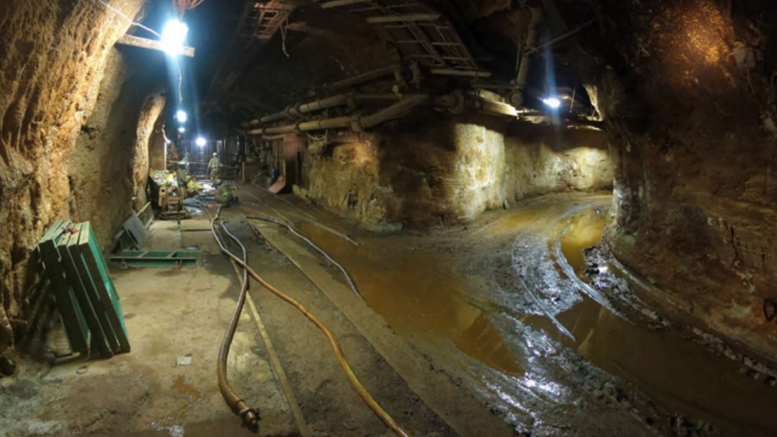VANCOUVER —Robert Friedland’s Ivanhoe Mines (TSX: IVN; US-OTC: IVPAF) has tabled a preliminary economic assessment (PEA) for the redevelopment of the brownfield Kipushi zinc-copper project in the Democratic Republic of the Congo (DRC). The plan will involve US$528 million in capital expenses, and take advantage of existing underground infrastructure, including vertical mine shafts, associated head frames and underground mine excavations.
The PEA focuses on Kipushi’s Big Zinc zone, which hosts 10.2 million measured and indicated tonnes grading 34.9% zinc. Wood Mackenzie says the grade is more than “twice as high” as comparable resources at the “world’s next-highest-grade zinc project.”

World’s major zinc mines, showing estimated annual zinc production and zinc head grades. Credit: Ivanhoe Mines.
Assuming a zinc price of US$2,227 per tonne, the mine plan features a US$533-million, after-tax net present value at an 8% discount rate, and a 30.9% internal rate of return.
Kipushi was previously mined from surface to 1,220 metres deep across three contiguous zones: the North and South zones of the Fault zone; and the Série Récurrente zone in the footwall of the fault, which is east–west striking and steeply north dipping.
The most recent addition to the underground workings — shaft #5 — runs 1,240 metres deep, and Ivanhoe plans to recommission it as its main access point. The shaft has a maximum hosting capacity of 1.8 million tonnes per year and would allow access to Big Zinc. The study contemplates an underground operation that would crank out an average 281,000 tonnes zinc-in-concentrate annually — plus minor copper — over a 10-year mine life, at by-product cash costs of US54¢ per lb. zinc.

Schematic of Kipushi cross-section showing mine infrastructure and the Big Zinc and Kipushi Fault Zones. Credit: Ivanhoe Mines.
Friedland said in its release that the mining and milling operation at Kipushi would be “straightforward,” and added that zinc inventories recently dropped to the lowest level since mid-2009, which he believes could lead to market conditions that are “ideal” to evaluate production options at the mine site.
Ivanhoe holds a 68% interest in Kipushi under a joint-venture agreement with the DRC’s state-owned mining company, Gécamines.
Exploration drilling confirmed last year that both Big Zinc and the Fault zone are open at depth and to the south.

Workers change valves at the 1,200-metre pump station. Credit: Ivanhoe Mines.
Ivanhoe hit a milestone at Kipushi late in 2015, when the water level in shaft #5 was drained below the 1,200-metre level, which hosts the mine’s main pumping station. The company has been dewatering the project since 2011, and expects the upgrade and refurbishment of the pumping infrastructure to cost US$3.8 million.
RBC Capital Markets analyst Fraser Phillips commented the results should be a “slight positive” for Ivanhoe shares, though the capital expense figure came in well above his US$326-million expectation. RBC models annual production at Kipushi of 306,000 tonnes zinc-in-concentrate over 14 years at a US61¢ per lb. cash cost.
Ivanhoe ended 2015 with US$294 million in cash and negligible debt. On March 23, Ivanhoe added US$41.2 million to its cash position after the first of five equal installments for its Kamoa transaction with China’s Zijin Mining.

Proposed Kipushi site layout. Credit: Ivanhoe Mines.
Meanwhile, BMO Capital Markets anaylst Aleksandra Bukacheva noted that the capital expense estimate in the PEA is “manageable.” BMO Research has a “market perform” rating on Ivanhoe shares, but no target price, due to an “extremely wide range of valuation outcomes for its shares.”
Bukacheva said that “the PEA represents a derisking milestone for Kipushi, as it sets the framework for a production restart path with a zinc production target that would make Kipushi one of the world’s five largest zinc mines, and it can be used as a source document to solicit development funding and/or partnership interest.”
Ivanhoe shares have traded in a 52-week range of 53¢ to $1.36, and have risen 64% — or 41¢ to start the year — en route to a $1.03-per-share close at press time. Ivanhoe has 779 million shares outstanding for an $800-million market capitalization.


Be the first to comment on "Ivanhoe outlines economics for Big Zinc at Kipushi"